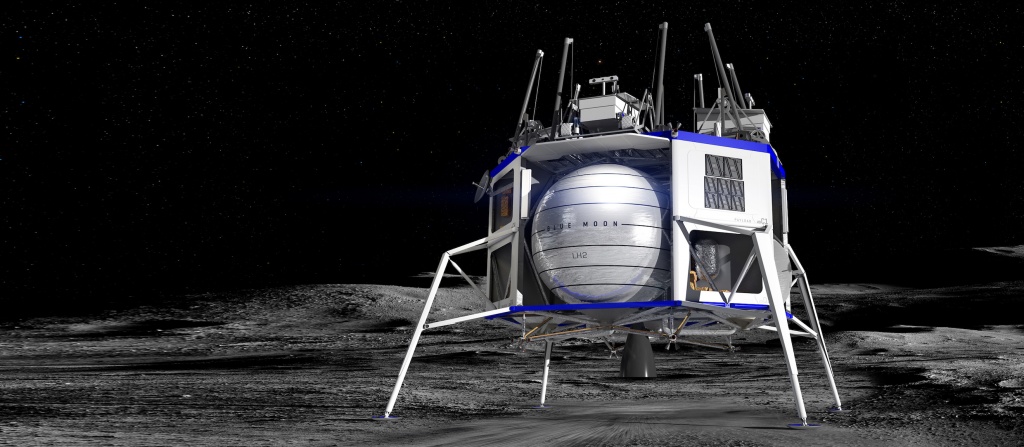New space companies and planetary science
This article has been contributed by Hans Huybrighs and Ottaviano Ruesch of the EPEC Future Research Working Group.
In the news, we often hear about New Space companies and their goals to ‘revolutionise’ the access and use of space. Think, for example, of Blue Origin and their planned Blue Moon lunar lander. These new opportunities to access planetary bodies are not, however, always considered in the planetary science community as serious options.
We wonder: are private space companies overlooked because there is some uncertainty as to whether they will eventually launch? Is it worth considering such opportunities when we think of the future of planetary science?
Here at the EPEC Future Research Working Group, we want to explore whether New Space companies will affect how we do research in the future. To find out more, we spoke with Dr Thorben Könemann, Deputy Scientific Director of the ZARM Drop Tower Operation and Service Company at the Center of Applied Space Technology and Microgravity (ZARM) in Bremen, and Dr Erika Wagner, payload sales director at Blue Origin in Kent, Washington.
‘Complementary’ is the keyword that Dr Könemann uses to describe the opportunities provided by New Space companies. His engineering team at ZARM integrates and supports microgravity experiments that have also flown onboard Blue Origin’s reusable launch vehicle, New Shepard, and Dr Könemann has been involved in those experiments from the beginning.
‘Blue Origin provides complementary access to space with a different set of boundary conditions for the payload than was previously available,’ Dr Könemann says. ‘Examples of such boundary conditions are: payload mass, duration and quality of microgravity, performance of the vehicle, and finally pricing. The availability of a new option increases the chance of finding a launcher that meets the requirement of an experiment and thus the chance to obtain an opportunity to fly.’
Although those experiments are generally more focused on microgravity research and less on planetary science, ZARM’s experience of becoming involved with Blue Origin still gives us lessons that can be applied to planetary science.
Through talking to Dr Könemann, it is clear that today, we are not necessarily witnessing a radical change in how space missions are developed, but rather an increase in the ways that space can be reached and studied. Flights provided by Blue Origin’s suborbital New Shepard rocket are an example of such new methods.
Dr Könemann states, ‘ZARM reached out early to potential new launch providers a decade ago. We not only contacted Blue Origin but also spoke to other upcoming companies, some of which don’t exist anymore.’
Therefore, even though the flight opportunities from new space companies for planetary science beyond Earth do not exist at present, it does make sense to establish relations with these companies early, so as not to miss out on these new opportunities later down the line.

Looking at the future and at rockets that can reach deep space, Dr Wagner says, ‘Blue Origin will be able to bring a considerable mass and volume of payload onto the surface of the Moon with the Blue Moon lunar lander. This would offer the opportunity to build heavier and more voluminous instruments.’
This is somewhat contrary to the trend of miniaturisation. It is the view of the EPEC Future Research WG that being aware of these opportunities from now will enable the community to develop instrumentation that makes optimal use of the new diverse platforms when they become available (and planning space missions is a long process – check out our series on the ESA Voyage 2050 white papers).
Dr Wagner also explains that of the 100 experiments to have flown on New Shepard, only 3 were funded by European agencies. Thus, it seems that there is a slower uptake on commercial opportunities in Europe when compared with the USA.
Dr Wagner suggests, “If early career researchers want to see an increase in this uptake, they could enable this change by advocating for the potential use of these new opportunities.”
For example, early career researchers can include these possibilities in white papers for government surveys equivalent to the US decadal survey, or through bodies such as the Space Generation Advisory Council (SGAC).
We conclude that new space companies could provide further opportunities in the future to reach our planetary destinations. To make the most of these opportunities, however, it helps to establish connections early, and early career researchers can encourage a move in this direction by advocating for links between planetary science and future launches by private space companies.
What are your thoughts about new space and planetary science? Let us know: epec.futureresearch@gmail.com
Find out more about the EPEC Future Research WG.
Banner image credit: Blue Origin.

